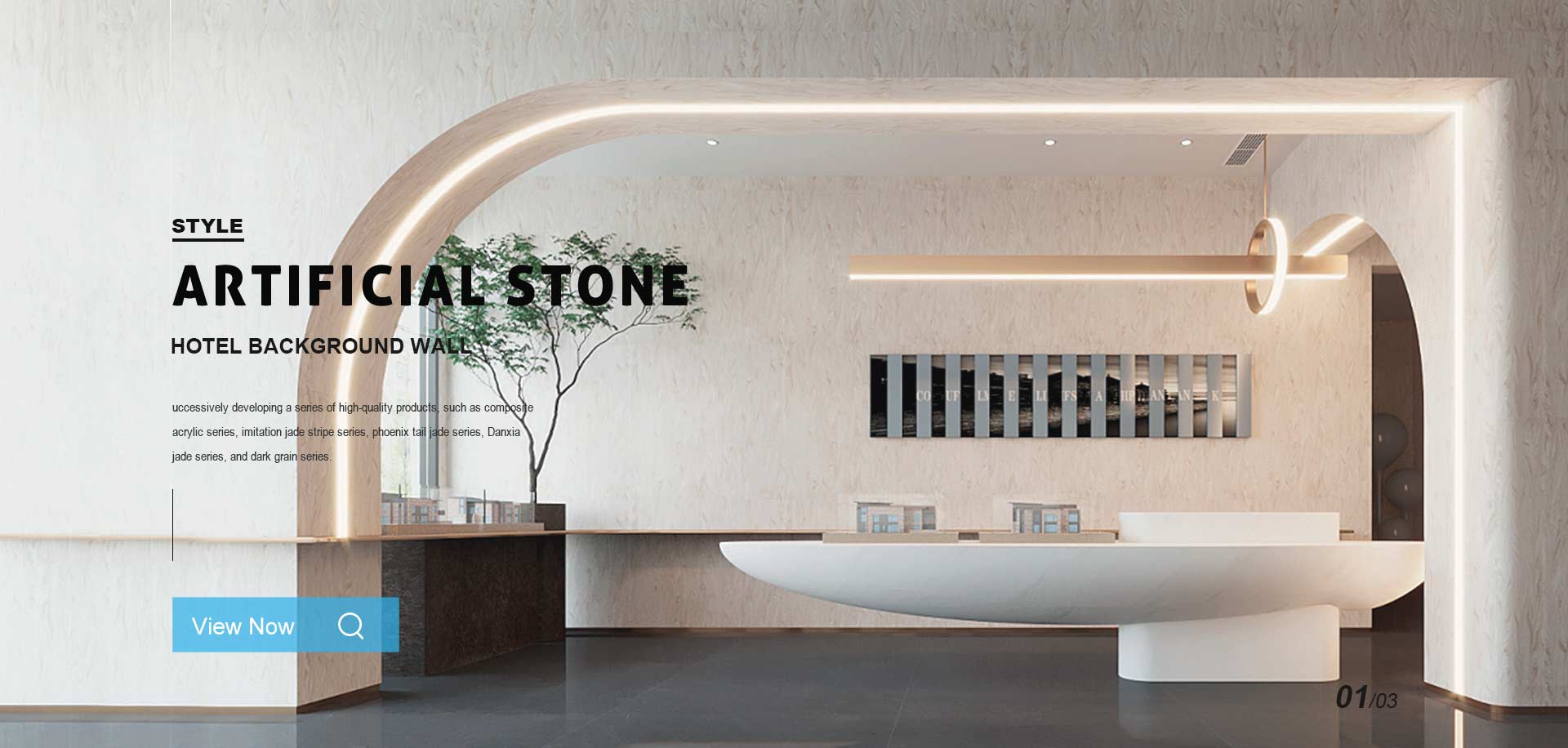
Solid Surface Slab, as a new type of building decoration material, has been widely used in interior design, furniture manufacturing, architectural decoration and other fields. Its unique physical and chemical properties make it highly competitive in the market.

1. Definition of Solid Surface panels
Solid surface panel is a composite material made of natural minerals and high-performance resin through a certain process. It is usually made of aluminum oxide (bauxite) and acrylic or polyester resin as the main raw materials, and is processed by mixing, pouring, curing and other processes. Solid surface panels are non-porous, homogeneous and repairable, and their appearance can simulate natural stone, wood and other materials.
2. Historical background of solid surface panels
Solid surface panels originated in the 1960s and were first invented and launched by DuPont in the United States under the trade name "Corian". The advent of this material has created a new era of building decoration materials. With the continuous advancement of technology, the production process and formula of Solid Surface Sheets have also been continuously improved, which has greatly expanded its performance and application scope. Today, solid surface panels have been widely recognized and used around the world.
3. Manufacturing process of solid surface panels
The manufacturing process of solid surface panels mainly includes the steps of raw material proportioning, mixing, pouring, curing, demoulding, grinding and polishing.
Raw material ratio: The main raw materials include aluminum oxide and resin. Colorants, additives, etc. can also be added according to different formulas. Scientific proportioning can ensure the excellent performance of solid surface panels.
Mixing: Mix the raw materials in proportion to fully combine the aluminum oxide and resin to form a homogeneous mixture.
Pouring: Pour the mixture into the pre-prepared mold. Different pouring processes can be used as needed, such as vacuum pouring, gravity pouring, etc.
Curing: Through a certain temperature and time, the resin in the mixture is cured to form a solid board.
Demolding: After curing is completed, the board is taken out of the mold for preliminary inspection and trimming.
Grinding and polishing: After grinding and polishing, the surface of the plate is smooth and flat to achieve the desired surface effect.
4. Performance characteristics of solid surface panels
Non-porous structure: The non-porous structure of solid surface panels makes them highly stain-resistant, easy to clean and maintain, and is particularly suitable for use in environments such as kitchens and bathrooms.
Repairability: If there are scratches or small damage on the surface of the board, it can be repaired by sanding and polishing to make it look like new.
Durability: Solid surface panels have good wear resistance, impact resistance and high temperature resistance, and have a long service life.
Environmental protection: Solid surface panels do not contain harmful substances, are harmless to human health, and meet modern environmental protection requirements.
Plasticity: The plate can be bent and formed after heating. It has good plasticity and can meet complex design needs.
5. Application fields of Solid Surface Sheets
The wide range of applications of solid surface sheets are mainly concentrated in the following aspects:
Kitchens and Bathrooms: Because they are stain-resistant, easy to clean and non-porous, solid surface panels are commonly used on kitchen countertops, vanities, bathtubs, shower walls and more.
Furniture manufacturing: Solid surface panels can be used to make a variety of high-end furniture, such as tables, cabinets, bookshelves, etc. Its diverse colors and textures can meet different decorative styles.
Public places: In public places such as hospitals, airports, shopping malls, etc., solid surface panels are widely used in the production of counters, walls, seats and other facilities due to their durability and easy maintenance.
Commercial display: In commercial display and exhibition design, solid surface panels are used to make various display racks, booths, etc. due to their plasticity and aesthetics.
6. Market prospects of solid surface panels
With the improvement of people's living standards and the improvement of living environment requirements, the market demand for solid surface panels continues to grow. Its characteristics of environmental protection, durability and beauty meet modern people's high requirements for building decoration materials. It is expected that the market for solid surface panels will continue to grow rapidly in the next few years.
7. Future development trends of solid surface panels
The future development of solid surface panels will be mainly reflected in the following aspects:
Technological innovation: With the continuous advancement of science and technology, the production process and raw materials of solid surface panels will continue to be improved, and the performance will be further improved.
Green and environmentally friendly: Future solid surface panels will pay more attention to environmental protection performance, using more renewable materials and environmentally friendly processes.
Personalized customization: As the demand for personalization increases, customized services for solid surface panels will become more popular and can better meet the personalized needs of consumers.
Intelligent applications: The development of smart homes will promote the application of solid surface panels in smart furniture, smart kitchens and other fields to achieve the integration of more functions.
As a new type of building decoration material, solid surface panels are becoming the darling of the market with their excellent performance and wide application prospects. With the continuous advancement of technology and changes in market demand, solid surface panels will continue to develop, bringing more convenience and beauty to people's lives. Whether in home decoration or public buildings, solid surface panels have demonstrated their unique charm and huge potential. In the future, solid surface panels will be used in a wider range of fields and become an important part of building decoration materials.